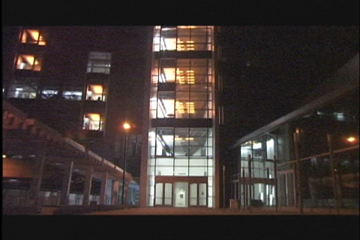ESI Ties a Green Ribbon Around UCSD
By Tiffany Fox, (858) 246-0353, tfox@ucsd.edu
San Diego, CA, May 20, 2008 -- Representatives from UC San Diego’s Environment and Sustainability Initiative – a campus-wide “green” collective based at Calit2’s La Jolla campus – gave a presentation about their focus and plans for the future at a Calit2 staff meeting last week, demonstrating the many ways that ESI’s mission dovetails with that of both the institute and the university.
ESI was established in 2005 as part of an effort by UCSD to bring together the intellectual resources of the campus around the challenges of environment and sustainability. According to Lisa Shaffer, executive director of ESI, sustainability can be broadly defined as “meeting today’s needs without compromising the ability of future generations to meet their needs.” Because sustainability has wide-reaching implications, ESI incorporates a vast array of partners across campus, including the Scripps Institution of Oceanography, the San Diego Supercomputer Center (SDSC), the Graduate School of International Relations and Pacific Studies (IR/PS) and the Rady School of Management (RSM), as well as academic departments ranging from humanities to engineering.
|
ESI director Paul Linden, who is also the chair of Mechanical and Aerospace Engineering at the Jacobs School of Engineering, gave the opening remarks at the presentation and expressed his gratitude for the resources and facilities that Calit2 provides to the organization.
“One of the driving tenets of ESI is that it’s an interdisciplinary activity,” Linden said. “It’s highly appropriate that we’re housed in Calit2, and,” he said with a laugh, “we’re very grateful that you allow us to ‘squat’ on your property.”
UCSD has committed to creating six faculty positions for interdisciplinary recruitments to support sustainability research and education. The first three positions are being defined now, based on multi-department proposals from across the campus.
To date, ESI has raised over $1.5 million in project funds and gifts from individual donors and foundations, including Wells Fargo Bank and the San Diego Foundation. That money has been allocated by ESI to faculty, researchers, and students in existing UCSD units to finance a number of sustainability projects. In addition to local projects that have made an impact on everything from wastewater treatment to the presence of metals within saltwater marshes, ESI is involved in global research through its participation on the Venice Lagoon Science Advisory Panel and the Association of Pacific Rim Universities, which has organized a project to examine how climate change affects water resources in Pacific Rim cities.
Another project due for unveiling just in time for graduation this year is the Sustainability Walk, a partnership between ESI, the Rady School, IR/PS and the campus operations staff. The walk, a campus-wide project designed to educate the public about sustainability, will “tie a very conspicuous green ribbon around campus and make sustainability visible,” Shaffer said.
Shaffer is hoping to help cultivate a similar effort on a city-wide level, in particular through her involvement with the San Diego Foundation’s Regional Focus 2050 Study. The foundation selected ESI, with Shaffer as principal investigator, to serve as project manager for the study, which will examine the impacts of climate change on San Diego and provide a snapshot of what the city might look like in 2050 if current climate and population trends continue. ESI is working in collaboration with a team of regional experts to provide an assessment to key decision-makers, including county officials, the Port of San Diego, tribal governments as well as the business and academic communities. The report is due for release at the end of June.
In its continuing effort to educate members of the campus community about carbon-neutral operations, renewable energy and waste reduction, ESI co-sponsored UCSD’s participation in “Focus the Nation,” a nationwide “teach-in” campaign designed to bring attention to the urgency of climate change. UCSD was one of more than 1,000 colleges and universities across the nation to participate in the January event, and more than 50 UCSD faculty integrated climate change solutions into their curriculum.
|
Calit2 Management Services Officer Yuki Marsden said that even before the video was showcased, officials at Atkinson Hall had decided to make some improvements to the building’s “eco” practices. Now most lights in the building are programmed to turn off at 8 p.m. In addition, the plastic liners have been eliminated from recycling bins, and in July, the campus Green Audit Team will do an audit of the building. Calit2 is also looking into working with the Jacobs School's Office of Engineering and Computing to shut down all computers at night automatically and then automatically turn them on in the morning so that they can be backed up and ready for use during the workday.
ESI encourages the campus-wide community to make similar types of efforts to encourage sustainability. When it comes to saving the planet, Shaffer says the role of the university is multi-faceted. UCSD can continue to play a significant part in moving beyond research and into action, she says, by creating new intellectual capital through interdisciplinary research, inventing new technologies, educating sustainability professionals, understanding and promoting social change and working with communities, industry and government.
Media Contacts
Tiffany Fox, (858) 246-0353, tfox@ucsd.edu
Related Links
UCSD's Environment and Sustainability Initiative
Scripps Institution of Oceanography
San Diego Supercomputer Center
Graduate School of International Relations and Pacific Studies
Rady School of Management
Jacobs School of Engineering
Atkinson Hall



